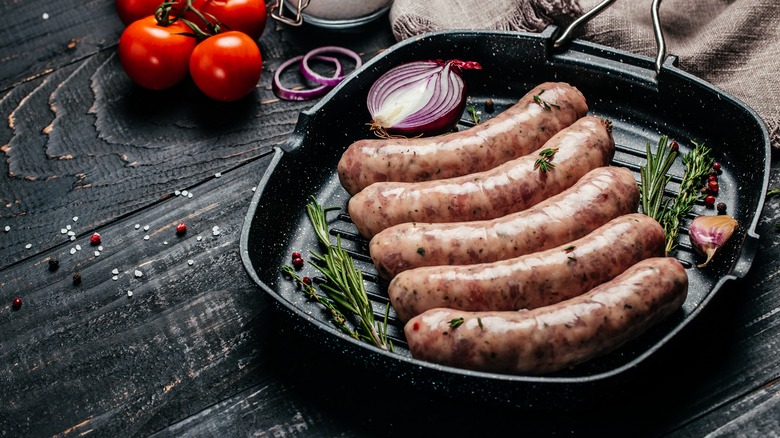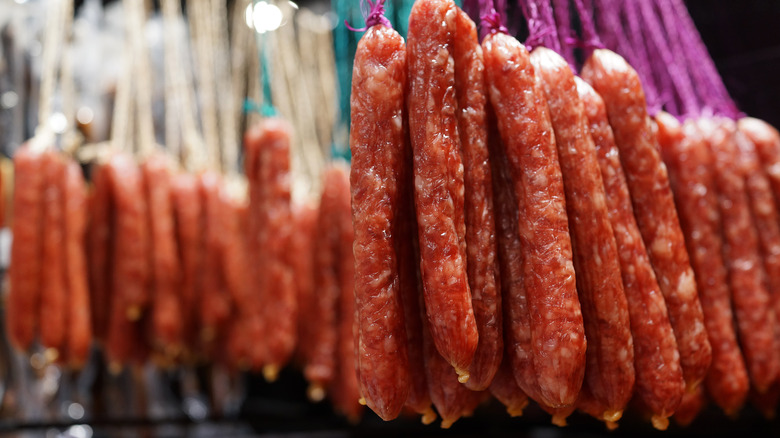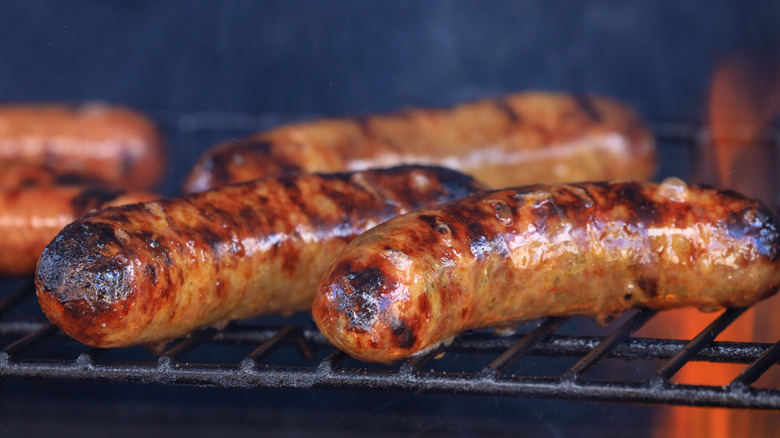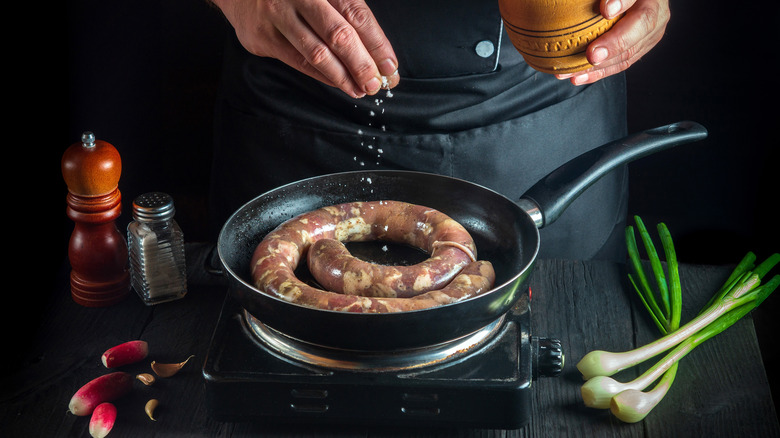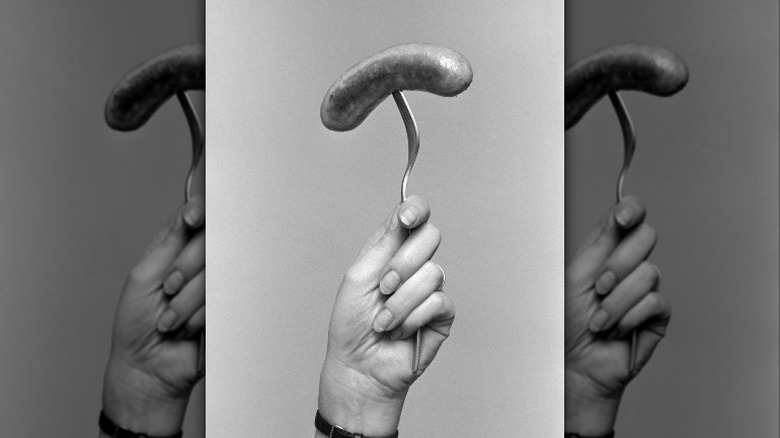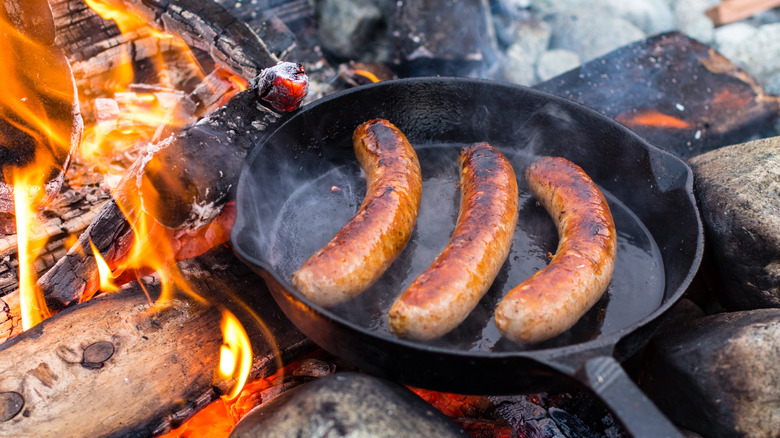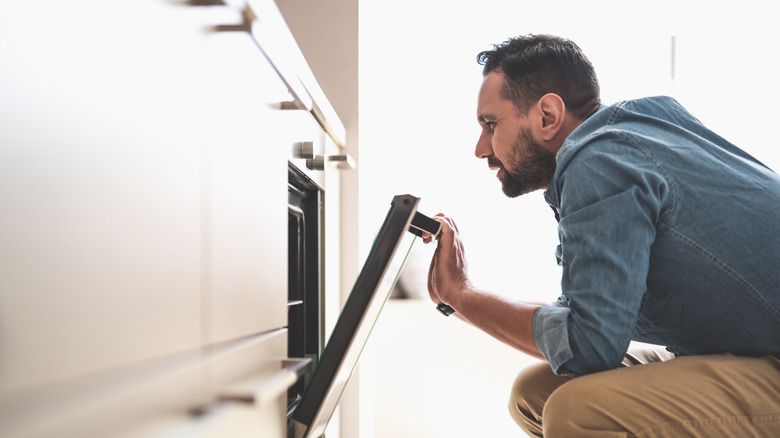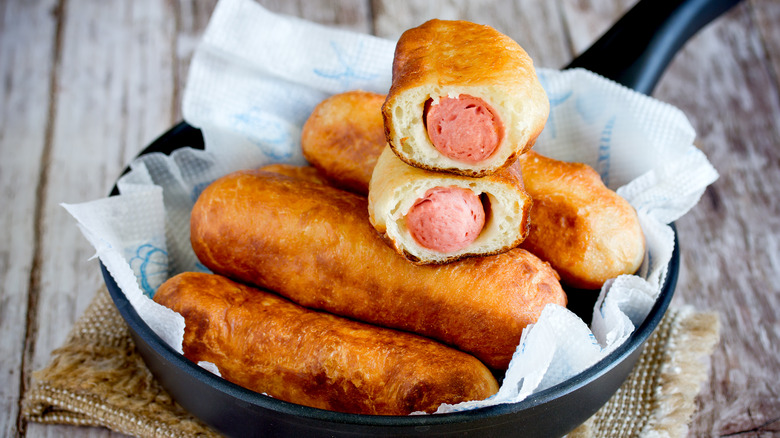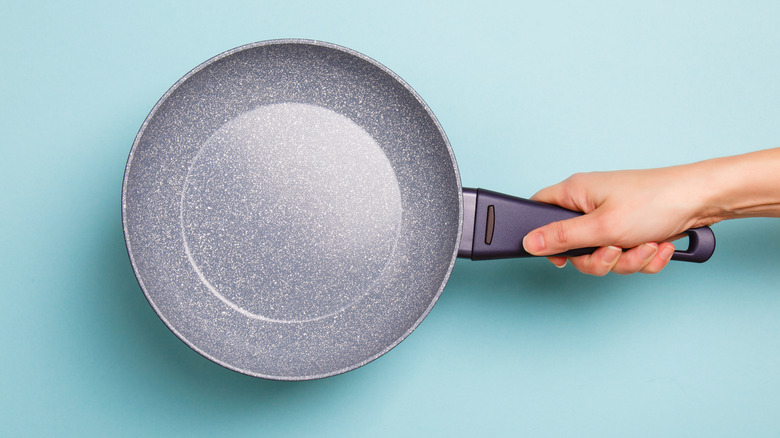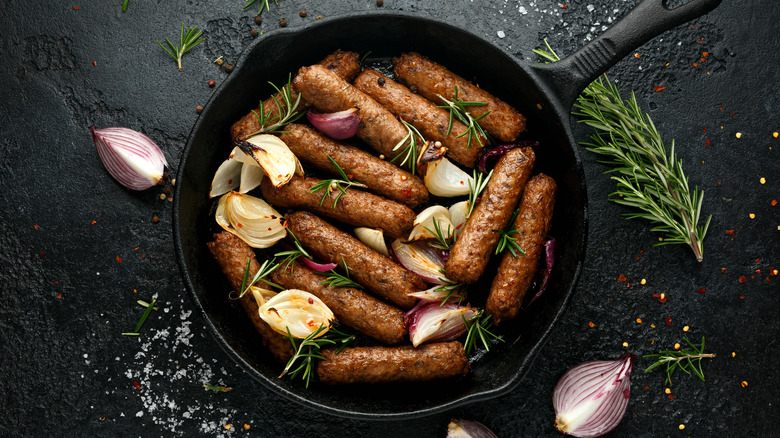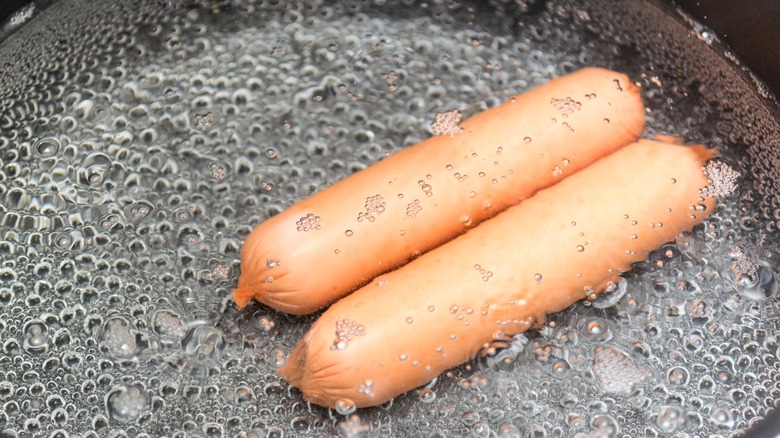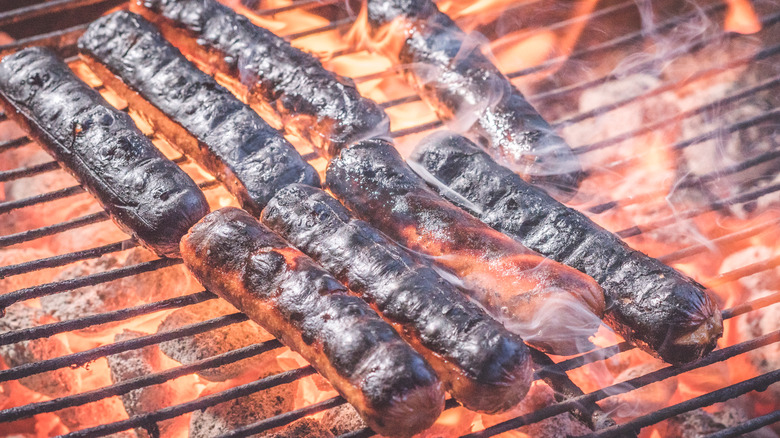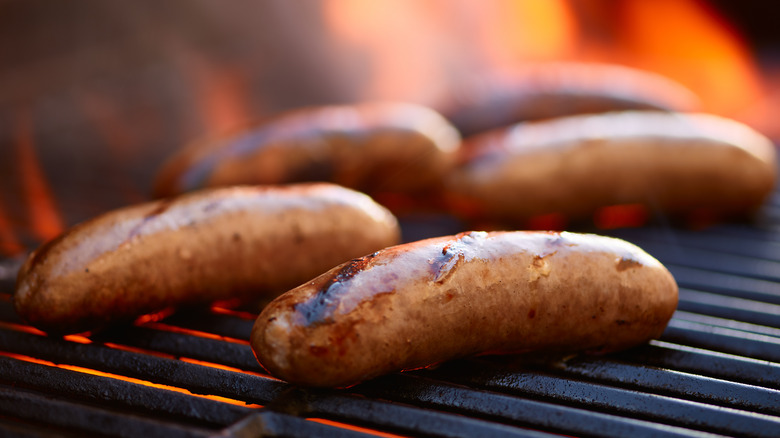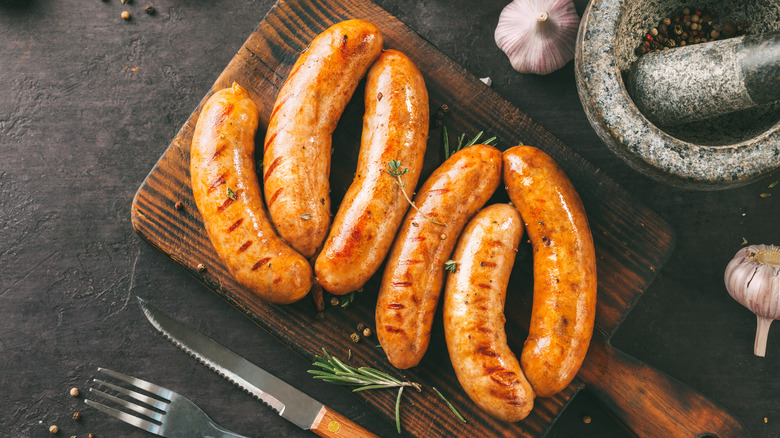Mistakes Everyone Makes When Cooking Sausage
Whether you prefer links of breakfast sausage alongside your scrambled eggs in the morning or a bratwurst on the grill, andouille sausage alongside your favorite New Orleans eats or Italian sausage alongside your best pasta dish, one thing's for sure — there are a lot of different ways to chow down on some tasty sausages. In fact, according to AllRecipes, there are more than 200 different varieties of sausage in the United States alone. However, for most varieties, the same standard cooking methods and tips and tricks apply (so long as you're cooking your sausages in links, that is); and, while you might think that cooking sausage is easy, there are actually quite a few ways you might be messing up the process. To help you cook up the best batch of sausages of your life, we've gathered the top 13 mistakes everyone makes when cooking sausage, and what you need to do instead.
Not paying attention to the type of sausage you buy
It shouldn't need saying, but here it is: Not all sausages are the same, and so you shouldn't treat them like they're the same. The Spruce Eats breaks sausages down into four main categories, which can be more useful than simply trying to learn and identify all the hundreds of sausage types that AllRecipes points to. These categories are fresh sausage, pre-cooked sausage, smoked sausage, and cured sausage.
Fresh sausages, like breakfast links and Italian sausage, are made from ground, uncooked meat and must be kept refrigerated and then cooked until done. They're great pan-fried or grilled. You can also remove the casing and use the interiors as a sausage crumble. Pre-cooked sausages, like hot dogs, are completely cooked and just need to be heated before eating; you can cook them the same way. Smoked sausages, like andouille and kielbasa, are smoked until done and can be used cold, heated, however you prefer. Cured sausage, like coppa and salami, meanwhile, reach "done" status by being salted and dried, and they're generally served without further cooking.
Marinating your sausages
We've all heard about soaking your brats in beer before grilling them, but is marinating sausages like this even really worthwhile? No — and here's why.
As the good people of Reddit point out, marinating sausages doesn't do much good. The sausage casing isn't porous enough to really allow in much extra flavor. If you do want any particular marinades in your sausage, you might want to just inject them straight into the casing, though that's a process that can be a little too time-consuming for the average home cook.
So why all the hype around soaking brats in beer? If you're not familiar with the process, it's important to know that most home cooks aren't just soaking their brats in beer before grilling. Instead, they're cooking the brats in beer. The pre-grill simmer cooks the brat interior, while the grill just adds on some extra caramelization and texture. Conversely, as The Memphis Flyer reports, you can let your brats or sausages spend their resting period after cooking in a beer bath, for more moisture. The experts interviewed in the article did mention that some home cooks will attempt to keep their sausages moist by soaking them in beer first, pre-grill, but it does little for the flavor. And, besides, they say, if your sausage dries out on the grill, you're probably doing it wrong or you bought a bad brat.
Adding your sausages to the pan immediately
We get it. You're hungry. You wake up. You want breakfast. You reach for the breakfast sausage links in the fridge, grab your favorite frying pan, and throw them in, waiting for the sizzle to start. However, you might want to show a little patience and wait a bit the next time you're making breakfast (or grilling brats or frying andouille or cooking any type of sausage any type of way). According to Premio Foods, manufacturer of a range of sausages, it's vital that you bring your sausages to room temperature before you start cooking. This means if your sausages are refrigerated, you should leave them out on the counter for a few minutes to bring them up to room temp. If your sausages are frozen, you'll want to let them thaw out in the fridge overnight and then let them come up to room temp further on the counter right before cooking.
Why is this so important? The rule actually applies to any cut of meat, as Bon Appetit explains. The longer the middle of your meat takes to cook, the more time the exterior of your meat has to overcook, as well as lose moisture. So if you bring your sausages to room temperature before you start cooking, the interior will cook more quickly, resulting in the perfect doneness both inside and out, as well as a juicier sausage.
Poking or cutting the sausage casing
Refrain from poking or cutting your sausage casings, as that can allow all those delicious juices to seep out of the sausage and into your grill or pan — and you don't want that (per Good Food Australia). To avoid pricking, use a pair of tongs to move your sausages as needed during the cooking process, rather than a fork.
But, what if you're trying to avoid fat? Won't pricking the sausage casings help to remove a little bit of your favorite food's fat content? Sure, but, as Good Food Australia notes, sausages are naturally fatty, and the fat accounts for a lot of a sausage's flavor. Letting all the fatty moisture seep out of your sausage just results in a less-tasty meal, especially if you're cooking a high-fat sausage (for reference, sausages in Australia can be made of up to 50% fat).
And, yes, we know, sometimes those casings burst on their own, even if you were extra-careful not to poke, prod, or cut. If you consistently struggle with burst casings, it's a sign that you're cooking your sausages at too high a temperature.
Starting out on high heat
Speaking of high temperatures, if you didn't come to this realization on your own, listen and understand: If you start cooking your sausage at too high a temperature, you run the risk of burning (or splitting) the exterior while leaving your interior uncooked. And though there are certain cuts of meat that you can easily sear and then finish off in the oven (like steak, for example), sausage is not one of them.
You want to start with low heat and then move on up to high heat. When you sear a steak and finish it off in the oven, you're cooking the exterior before the interior; with sausage, you want to cook the interior before the exterior. That's why our preferred method of sausage cooking on this list is via simmering and then sautéing (as Bon Appetit suggests, and which we'll get to in a bit). The inside is finished while the outside is crisped up and caramelized. You get a fully-done, totally-safe-to-eat sausage that's moist on the inside, with a nice bite on the outside.
But this method doesn't only apply to the stovetop. Even if you cook your sausages on the grill, you want to start out on low, indirect heat, and get those sausages cooked through before you add on a little extra flame-grilled color.
Baking your sausages
Baking is a popular pick for a lot of types of meat, and for good reason. Baking is just easier. You throw your cut of meat in a casserole dish, toss it in the oven, and wait for it to be done. There's no babysitting at the stove or grill required. However, you may want to leave the baking for your chicken thighs. Baking sausage requires you to walk a delicate line between undercooked and overcooked, and it's all too easy to mess up. In fact, you might find yourself doing just as much babysitting as you would if you were to simply cook your sausages on the stovetop.
As Home Kitchen Talk details, since it's difficult to get the temperature and the cooking time just right for your individual sausages, you'll likely have to use a meat thermometer to check your sausages' doneness or have to cut straight into them to visually check for blood or any pink. Say goodbye to those precious fatty juices, because now they're all in the bottom of your casserole dish (via Good Food Australia).
Deep-frying your sausages
We know that we just mentioned how the fat in the sausage is the good stuff — and it is (via Good Food Australia). All that fatty content adds flavor and moisture that makes a sausage, well, a sausage. However, there's no reason to add even more fat content to your favorite link via deep-frying, especially when there are easier (and less messy) methods of cooking.
Typically, when you deep-fry a sausage, you'll bread it beforehand and then fully immerse the sausage in your oil of choice. However, as Healthline notes, doing this results in a significant increase in fat and calories. Additionally, deep-frying may increase your risk of carcinogen exposure (via the British Journal of Cancer and Environmental Science and Pollution Research). So, if you're going to cook sausage any way at all, just avoid the deep-frying, especially if you're watching your fat or caloric intake. You could definitely pick a healthier option.
Cooking in a dry pan
Sure, some will tell you that your sausages have enough natural fat that they can cook in a pan all on their own, no problem. But if you're cooking your sausages in their own fat, that means the fat is leaking out from somewhere, which we don't want (via Good Food Australia). So instead, add fat or water or both to your pan for a moisture-locking fry (without heading into deep-frying territory).
One cooking method that uses both fat and water is brought to us by the experts at Bon Appetit (and it's the aforementioned favorite!). They recommend a two-step, simmer-and-sear process. All you have to do is place your sausages in just enough water to cover them and then cook them until the water simmers. Once they're cooked entirely through, you'll add them to a pan with a sheen of hot oil to crisp up the exteriors until they're just as golden-brown as you like. This easy process results in sausages that are reliably cooked through, moist, and never overcooked on the exterior.
Crowding the pan
Just as the rule about letting your sausage come to room temperature before cooking can apply to a range of foods, so can this rule about crowding your pan. When cooking sausage, or really anything in a pan on the stovetop, you don't want to crowd things. It's one of the most basic cooking rules, but also one of the easiest for newer cooks to ignore.
Here's why it's so important, according to Real Simple: When you have too many items in a pan, the heat gets stuck beneath all your food. The moisture from the food escapes upward, creating steam, but the bulk of the heat remains on the bottom of your pan. So your food will cook, but it won't necessarily be cooked to perfection. Think dry, unevenly cooked, and overall sad sausages. For peak caramelization, moisture, and flavor, you want to leave your pan uncrowded so all the heat from the bottom of the pan can rise upward, circulating in the air around your food.
Boiling your sausages in water
Okay, okay, okay. We get it. We just told you about the amazing simmer-and-sauté method, as well as simmering your sausages in beer before grilling. And now we're telling you not to boil your sausages?
Well, sort of. The secret to a perfect sausage is all in the details, and while simmering and then sautéing your sausage will yield excellent results, simply boiling your sausage in water and then doing nothing else will result in a very lackluster experience. Just imagine it. That sausage is going to have no char, no color, nothing. It's a gray, sad shaft of meat; the only thing it's got going for it is that it's cooked.
If you really do want to boil your sausages, though, you can add extra flavor by following Bon Appetit's recommendation to boil emulsified sausages (which include bratwurst, hot dogs, and similar sausages) in something other than water, such as stock, beer, wine, or tomato sauce.
Overcooking your sausages
It's all too easy to overcook a sausage. For your best chances at avoiding this, you'll want to do a few things, says Johnsonville, arguably America's most well-known brat and sausage brand.
First, whether you simmer your hot dogs before you sauté them or you send them straight to the grill, make sure you keep things at low heat. Turning things up too high can result in overcooked sausages that are crispy on the outside long before they ever get cooked through on the inside. Additionally, if you're grilling, opt to cook your sausages over indirect heat.
Once you're done with the actual cooking process, though, you're still not done. You'll want to account for carryover cooking, in which the heat inside the sausages will cause them to continue to cook even after you've taken them off the heat. That's because the internal temperature of a cooked item rises for a certain amount of time before it plateaus and then decreases. So if you've cooked your sausages to the perfect internal temperature before removing them from your heat source, you could actually end up with overcooked sausages. To combat this, Johnsonville recommends you remove your sausages from the heat source once they've reached about 5 degrees below your desired temperature.
Not going the extra mile at the grill
We've mentioned grilling many times over the course of this article, as it's one of the most popular ways to cook sausages, especially options like bratwursts or hot dogs. But don't just assume that you can throw some sausages on the grill and walk away. If you're going to opt for grilling your sausages, you need to go the extra mile to ensure you do it the right way. As we covered in a prior Mashed article, you want to ensure that you follow all the rules to get a great sausage by defrosting your meat, grilling at a low temperature or on indirect heat, not piercing your sausages, and not crowding the grill. You'll also want to take a few extra precautions with your grill, by cleaning it ahead of time and using high-quality grilling tools that can handle your sausages.
There's also a special caveat that you can take advantage of when grilling. According to Johnsonville, while you should never cut or poke a fresh sausage, if you have smoked brats, you can give it a fresh-grilled flavor by giving it the butterfly treatment.
Not waiting to chow down
And, lastly, another staple rule for cooking any meat: Allowing your meat — sausage or otherwise — to rest before serving is an important part of the process. Yes, even for those grilled brats. While you may be tempted to dig in as soon as the brat hits the plate, wait a second. As Men's Health advises, let your sausages rest for four to five minutes before you cut or bite into them.
When you cook meat, the liquid in the meat moves toward the exterior, trying to escape. However, if you allow the meat to cool just a bit off of the heat, that gives the moisture and liquid enough time to redistribute throughout the entirety of your cut or link, leaving you with a perfectly moist sausage rather than a sausage that's sitting in a pool of its own juices, which have all leaked out because you couldn't wait a mere five minutes (via Kitchn).
